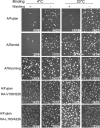Improvement of influenza A/Fujian/411/02 (H3N2) virus growth in embryonated chicken eggs by balancing the hemagglutinin and neuraminidase activities, using reverse genetics
- PMID: 15890915
- PMCID: PMC1112156
- DOI: 10.1128/JVI.79.11.6763-6771.2005
Improvement of influenza A/Fujian/411/02 (H3N2) virus growth in embryonated chicken eggs by balancing the hemagglutinin and neuraminidase activities, using reverse genetics
Abstract
The H3N2 influenza A/Fujian/411/02-like virus strains that circulated during the 2003-2004 influenza season caused influenza epidemics. Most of the A/Fujian/411/02 virus lineages did not replicate well in embryonated chicken eggs and had to be isolated originally by cell culture. The molecular basis for the poor replication of A/Fujian/411/02 virus was examined in this study by the reverse genetics technology. Two antigenically related strains that replicated well in embryonated chicken eggs, A/Sendai-H/F4962/02 and A/Wyoming/03/03, were compared with the prototype A/Fujian/411/02 virus. A/Sendai differed from A/Fujian by three amino acids in the neuraminidase (NA), whereas A/Wyoming differed from A/Fujian by five amino acids in the hemagglutinin (HA). The HA and NA segments of these three viruses were reassorted with cold-adapted A/Ann Arbor/6/60, the master donor virus for the live attenuated type A influenza vaccines (FluMist). The HA and NA residues differed between these three H3N2 viruses evaluated for their impact on virus replication in MDCK cells and in embryonated chicken eggs. It was determined that replication of A/Fujian/411/02 in eggs could be improved by either changing minimum of two HA residues (G186V and V226I) to increase the HA receptor-binding ability or by changing a minimum of two NA residues (E119Q and Q136K) to lower the NA enzymatic activity. Alternatively, recombinant A/Fujian/411/02 virus could be adapted to grow in eggs by two amino acid substitutions in the HA molecule (H183L and V226A), which also resulted in the increased HA receptor-binding activity. Thus, the balance between the HA and NA activities is critical for influenza virus replication in a different host system. The HA or NA changes that increased A/Fujian/411/02 virus replication in embryonated chicken eggs were found to have no significant impact on antigenicity of these recombinant viruses. This study demonstrated that the reverse genetics technology could be used to improve the manufacture of the influenza vaccines.
Figures



Similar articles
-
Single amino acid substitutions in the hemagglutinin of influenza A/Singapore/21/04 (H3N2) increase virus growth in embryonated chicken eggs.Vaccine. 2006 Nov 10;24(44-46):6691-3. doi: 10.1016/j.vaccine.2006.05.062. Epub 2006 Jun 9. Vaccine. 2006. PMID: 16814431
-
Molecular changes associated with adaptation of human influenza A virus in embryonated chicken eggs.Virology. 2006 Jun 20;350(1):137-45. doi: 10.1016/j.virol.2006.02.020. Epub 2006 Mar 20. Virology. 2006. PMID: 16545416
-
The impact of key amino acid substitutions in the hemagglutinin of influenza A (H3N2) viruses on vaccine production and antibody response.Vaccine. 2010 May 28;28(24):4079-85. doi: 10.1016/j.vaccine.2010.03.078. Vaccine. 2010. PMID: 20399830
-
Functional balance between neuraminidase and haemagglutinin in influenza viruses.Clin Microbiol Infect. 2016 Dec;22(12):975-983. doi: 10.1016/j.cmi.2016.07.007. Epub 2016 Jul 15. Clin Microbiol Infect. 2016. PMID: 27424943 Review.
-
H3N2 influenza viruses in humans: Viral mechanisms, evolution, and evaluation.Hum Vaccin Immunother. 2018;14(8):1840-1847. doi: 10.1080/21645515.2018.1462639. Epub 2018 May 14. Hum Vaccin Immunother. 2018. PMID: 29641358 Free PMC article. Review.
Cited by
-
Structural and functional analysis of the hemagglutinin-esterase of infectious salmon anaemia virus.Virus Res. 2010 Aug;151(2):131-41. doi: 10.1016/j.virusres.2010.03.020. Epub 2010 Apr 14. Virus Res. 2010. PMID: 20398710 Free PMC article.
-
Influenza H1N1 A/Solomon Island/3/06 virus receptor binding specificity correlates with virus pathogenicity, antigenicity, and immunogenicity in ferrets.J Virol. 2010 May;84(10):4936-45. doi: 10.1128/JVI.02489-09. Epub 2010 Mar 3. J Virol. 2010. PMID: 20200248 Free PMC article.
-
Deletions of neuraminidase and resistance to oseltamivir may be a consequence of restricted receptor specificity in recent H3N2 influenza viruses.Virol J. 2009 Feb 14;6:22. doi: 10.1186/1743-422X-6-22. Virol J. 2009. PMID: 19216793 Free PMC article.
-
Development of a high-yield live attenuated H7N9 influenza virus vaccine that provides protection against homologous and heterologous H7 wild-type viruses in ferrets.J Virol. 2014 Jun;88(12):7016-23. doi: 10.1128/JVI.00100-14. Epub 2014 Apr 9. J Virol. 2014. PMID: 24719414 Free PMC article.
-
Establishment of a mouse- and egg-adapted strain for the evaluation of vaccine potency against H3N2 variant influenza virus in mice.J Vet Med Sci. 2021 Oct 31;83(11):1694-1701. doi: 10.1292/jvms.21-0350. Epub 2021 Sep 14. J Vet Med Sci. 2021. PMID: 34526415 Free PMC article.
References
-
- Blick, T. J., A. Sahasrabudhe, M. McDonald, I. J. Owens, P. J. Morley, R. J. Fenton, and J. L. McKimm-Breschkin. 1998. The interaction of neuraminidase and hemagglutinin mutations in influenza virus in resistance to 4-guanidino-Neu5Ac2en. Virology 246:95-103. - PubMed
-
- Blick, T. J., T. Tiong, A. Sahasrabudhe, J. N. Varghese, P. M. Colman, G. J. Hart, R. C. Bethell, and J. L. McKimm-Breschkin. 1995. Generation and characterization of an influenza virus neuraminidase variant with decreased sensitivity to the neuraminidase-specific inhibitor 4-guanidino-Neu5Ac2en. Virology 214:475-484. - PubMed
-
- Centers for Disease Control and Prevention. 2004. Update: influenza activity—United States, 2003-04 season. Morb. Mortal. Wkly. Rep. 53:284-287. - PubMed
-
- Couceiro, J. N., J. C. Paulson, and L. G. Baum. 1993. Influenza virus strains selectively recognize sialyloligosaccharides on human respiratory epithelium; the role of the host cell in selection of hemagglutinin receptor specificity. Virus Res. 29:155-165. - PubMed
-
- Daniels, P. S., S. Jeffries, P. Yates, G. C. Schild, G. N. Rogers, J. C. Paulson, S. A. Wharton, A. R. Douglas, J. J. Skehel, and D. C. Wiley. 1987. The receptor-binding and membrane-fusion properties of influenza virus variants selected using anti-haemagglutinin monoclonal antibodies. EMBO J. 6:1459-1465. - PMC - PubMed
Publication types
MeSH terms
Substances
LinkOut - more resources
Full Text Sources
Other Literature Sources

